I asked, y'all danced (or sang or shook rattles at the sky or whatever). It finally RAINED here. OK, just a little under a half inch according to our rain gauge west of town but that will certainly do for starters. Others got more. I'm not greedy.
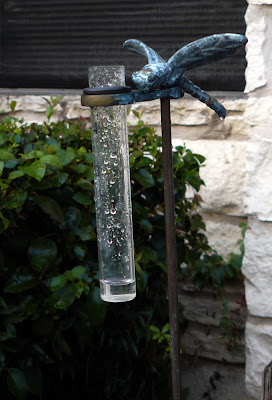
Better yet, our six rain barrels were all completely filled with that one teensy shower. Now we just have to figure out how to get the gallons of water out of the barrels and on to our plants. That is definitely the weakest link in the rain conservancy chain under this system. I nervously turned the nozzle control on the hose to get water from our full to the top barrel and the water just moseyed on out, a trickle at a time. No real pressure means no real "stream" of water.

That's OK. The water won't be going anywhere while we figure out a better way to move it from the barrel to the bed.
Meanwhile back in the yard..

I believe we have established that I pretty much suck at identifying stuff. Whenever I spot an unusual plant or bug or snake or bird I go online and find all sorts near misses. My flora and fauna will look just like a this or a that only missing some signature element. It can be very frustrating so I readily turn to experts whenever I can.
Sometimes this yields quick results. Other times, well, let's just say it has been a long day today in the science lab otherwise known as our back yard.

I currently have a plant growing that is stumping the plant identification stars at the Wildflower Center. It might be a Chamaesyce Angusta, commonly called a Blackfoot Sandmat. Or not. It is likely some form of Spurge, a plant name that makes me want to go wash my hands just from typing it out.
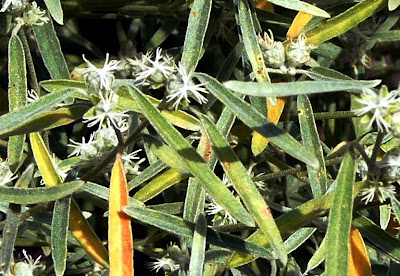
"Sweetie- please. Do
not get any of that spurge on the kitchen counter. That's where Mommy fixes our
food!"...
This mystery plant is also probably a Euphorbia which while not much better than Spurge at least sounds a little happier. "Bob's euphorbia quickly wore off as he realized that despite the rising poll numbers, the election was still four weeks away."
When asked, Mr. and Ms. Smarty Plants, Ladybird Johnson Wildflower Center personnel, flora identification gurus if there ever were any, quickly clarified that
no I would not win a prize for having a plant naturally occur in my yard they cannot identify. I was however, assured my name will probably now feature prominently in epic wild plant poetry and I will be sung about around campfires on clear nights.
I suppose that will have to do.
I also currently have unanswered questions about the sudden appearance of dozens of (apparently feeding) bees up in the canopy of one of our live oaks. This does not seem to have anything to do with generalized swarming or establishing a new hive in the tree, it is as if there were flowers up there, or at least some source of nectar or nectar substitute that is drawing them in to feed.
I tried to get a clear photo of the bees but two stories down that ended up being an in and out version of that cell phone ad.
Out I would go to take 8-10 shots of the tree canopy.
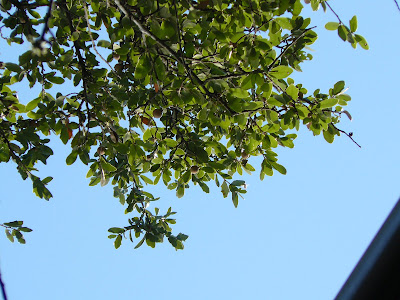
In I would go to download the photos and zoom in. Can you see bees
now?

Again I eagerly turned to the Wildflower Center, my bastion of wisdom in such matters and then more reluctantly to the County Extension Agent, the other source for when you simply need to know what the hell is going on outside in your yard. I admit, to me it is a snob thing. Wildflower Center = elite. County Extension Agent = redneck. That's not true at all of course, that's just me feeling peckish for being a written off blue voter in a bloodbath of a red state. But back to the garden.
No answers to my bees in the trees queries either.
Besides my generally futile bee paparazzi stint, I ended up taking a lot of directed photographs today to help my outsourced botanical brains give me the answers I required ..."can you get a close up of the underside of those spheres (that are 1/16th of an inch at best) and tell me if they are tri-lobulate?". "Can you get a shot of both sides of the leaves? Oh- and are they alternate or opposite?",
Honey. If I could spot if those 1/16th of an inch spheres were trilobulate that would mean I could A) throw away my multifocals and 2)open up my own "Plant Identification" shop. And the leaves? As far as I could tell they were both - alternate AND opposite. See why I stink at identification?
Anyway. In the midst of all this close up photography and surveillance of the ground around the bugged live oak in our back yard to see if there were any fallen insects, I found instead a fallen tree branch that was festooned with several different types of lichen.

It was fascinating, and in my investigation to see if there was some way I could keep it growing, I discovered there is a lot more to lichens than meets the eye.
Did you know there are 3 forms of lichen? I didn't. And here is where it gets a bit "R" sounding, so parents, cover your kiddies' ears. There are foliose, crustose and fruticose lichen, all relating to the structure the lichen takes.
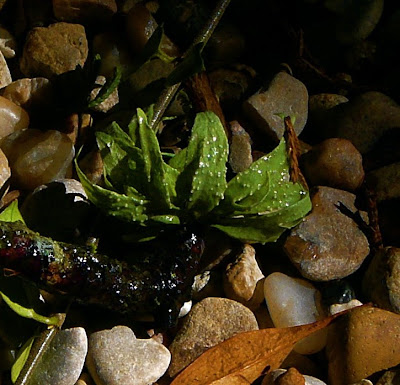
Foliose are leafy and adhere to the substrata (in this case a branch) at several points under the thallus while the edges of the thallus generally turn upward.
The thallus (I had to look this up) is the main body of the lichen.
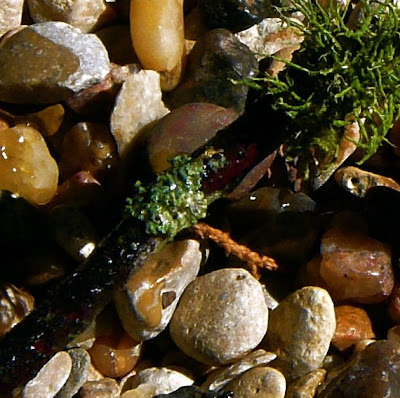
Crustose lichens (crusty) adhere closely to the bark at all points under the thallus. Removal from the substrata causes extensive damage. These lichens can survive in harsher environments than the other groups. More on that in a moment.
Finally there are Fruticose lichens. These are stalked, shrubby, or hair-like and attach to the bark at a single spot. These look like trees or bushes with a more upright structure.

Fruticose lichens are easy to remove and prefer a spot with more light. They typically are found out closer to the ends of limbs or branches - in higher light areas.
It turns out lichens are the plant version of the canary in the coal mine when it comes to certain pollutants in the air. Since they derive their nutrients from airborne particles, they are great monitors of air quality. This means when I find a branch encrusted with several types of lichen, I probably ought not think "Ewww - lichen!" but rather should be grateful I live in an area where lichen commonly occur. If they can breathe in what they need to thrive here, then so can I. And unlike ball moss, they do not harm the trees they attach to.
The last fun fact to share is that lichen are actually not one organism but two living in symbiosis. They are composed of a fungus called the "myobiont" and one or more algae or cyanobacter called a "photobiont". What the frak! How fun is that? If I told you more I'd probably get us both on some "no fly list". As it is I am verging on stuffing so much new information into my brain that if I persist I will probably lose my ability to recall something I already know, like how to tell when pasta is done.
You go ahead and study up more on lichen if you wish and I'll keep you posted about my mystery plant and the bees in the trees. Ain't nature grand....
 Check it out - jewelry for your trees...
Check it out - jewelry for your trees... Anybody seen anything like this on an actual tree? I am imagining these appear mostly inside gated properties. The closest thing to this I've seen in Central Texas are tree faces.
Anybody seen anything like this on an actual tree? I am imagining these appear mostly inside gated properties. The closest thing to this I've seen in Central Texas are tree faces. Can't imagine we will have to wait too long for tree earrings to make an appearance.
Can't imagine we will have to wait too long for tree earrings to make an appearance.




